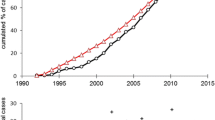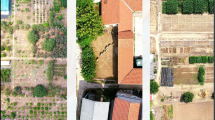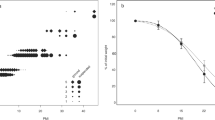Abstract
Forensic entomology has been developing globally for decades. Despite this discipline being used in criminal investigations around the world, only a few controlled studies have been performed on human cadavers in human decomposition facilities, with the majority of these being conducted in warm and often dry climates. Therefore, the purpose of our research was to catalogue the first published data on insects associated with decomposed human bodies in a humid, continental (Dfb) climate. Specifically, our objective was to document the diversity and succession of the entomofauna associated with human cadavers throughout the decomposition process, in the Quebec province of Canada, during the summer season. Two human cadavers were studied in 2020 at the site for Research in Experimental and Social Thanatology, REST, located in Bécancour (Quebec, Canada). Insects (and other arthropods) were regularly sampled by visual observations, collection from the cadavers, and by using an entomological net and pitfall traps. Our results highlight that the decomposition process is a heterogeneous and complex process in Quebec, with cadavers showing signs of precocious desiccation/mummification. In addition, our observations confirm that the presence of superficial skin lesions accelerates the colonization of blow flies (Diptera: Calliphoridae) and, consequently, the process of decomposition. Finally, we were able to discriminate between “early colonizers” (e.g., Calliphoridae Lucilia sp. or Calliphora livida), “late colonizers” (e.g., larvae of Piophilidae or Heleomyzidae), and “non-specific colonizers.” We also officially report the first observation of Cochliomyia macellaria (Diptera: Calliphoridae) in Quebec. These findings will provide new information to help medico-legal death investigations by determining the minimum time elapsed since death and the circumstances surrounding death.




Similar content being viewed by others
Data availability
Data are available upon request.
References
Huntington TE, Weidner LM, Hall RD (2020) Introduction: current perceptions and status of forensic entomology. In: Byrd JH, Tomberlin JK, eds. Forensic entomology: the utility of arthropods in legal investigations Third edition. CRC Press, Taylor & Francis Boca raton, FL. pp. xxiii-xxxiv
Niederegger S, Mall G (2021) Flies do not jump to conclusions: estimation of the minimum post-mortem interval for a partly skeletonized body based on larvae of Phormia regina (Diptera: Calliphoridae). Insects 12. https://doi.org/10.3390/insects12040294
Lefebvre F, Gaudry E (2009) Forensic entomology: a new hypothesis for the chronological succession pattern of necrophagous insect on human corpses. Ann Soc Entomol Fr 45:377–392. https://doi.org/10.1080/00379271.2009.10697622
Anderson G (1999) Wildlife forensic entomology: determining time of death in two illegally killed black bear cubs. J Forensic Sci 44:856–859. https://doi.org/10.1520/JFS14567J
VanLaerhoven SL, Merritt RW (2019) 50 years later, insect evidence overturns Canada’s most notorious case — Regina v. Steven Truscott. Forensic Sci Int 301:326–330. https://doi.org/10.1016/j.forsciint.2019.04.032
Lord WD (1990) Case histories of use of insects in investigations. In: Catts EP, Haskell NH (eds) Entomology and death, a procedural guide. Joyce’s Print Shop Inc., Clemson, pp 9–37
Matuszewski S, Szafałowicz M, Grzywacz A (2014) Temperature-dependent appearance of forensically useful flies on carcasses. Int J Leg Med 128:1013–1020. https://doi.org/10.1007/s00414-013-0921-9
Schroeder H, Klotzbach H, Püschel K (2003) Insects’ colonization of human corpses in warm and cold season. Legal Med 5:S372–S374. https://doi.org/10.1016/S1344-6223(02)00135-9
Archer MS (2004) Annual variation in arrival and departure times of carrion insects at carcasses: implications for succession studies in forensic entomology. Aust J Zool 51:569–576
Tarone AM, Foran DR (2006) Components of developmental plasticity in a Michigan population of Lucilia sericata (Diptera: Calliphoridae). J Med Entomol 43:1023–1033. https://doi.org/10.1603/0022-2585(2006)43[1023:codpia]2.0.co;2
McAlpine JF, Peterson BV, Shewell GE, Teskey HJ, Vockeroth JR, Wood DM (1987) Manual of Nearctic Diptera. Volume 2. Agriculture and Agri-Food Canada. Research Branch. Ottawa (Ontario) Canada
Moreno EA, Amat E, Meneses PE, Donoso DA, Barragán ÁR (2020) Green bottle flies (Calliphoridae, Luciliinae) of Ecuador: geographic distribution, checklist and DNA barcodes. Neotropical Biodiversity 6:117–126. https://doi.org/10.1080/23766808.2020.1804747
Matuszewski S, Hall MJR, Moreau G, Schoenly KG, Tarone AM, Villet MH (2020) Pigs vs people: the use of pigs as analogues for humans in forensic entomology and taphonomy research. Int J Leg Med 134:793–810. https://doi.org/10.1007/s00414-019-02074-5
Dawson BM, Barton PS, Wallman JF (2020) Contrasting insect activity and decomposition of pigs and humans in an Australian environment: a preliminary study. Forensic Sci Int 316:110515. https://doi.org/10.1016/j.forsciint.2020.110515
Knobel Z, Ueland M, Nizio KD, Patel D, Forbes SL (2019) A comparison of human and pig decomposition rates and odour profiles in an Australian environment. Aust J Forensic Sci 51:557–572. https://doi.org/10.1080/00450618.2018.1439100
Connor M, Baigent C, Hansen ES (2018) Testing the use of pigs as human proxies in decomposition studies. J Forensic Sci 63:1350–1355. https://doi.org/10.1111/1556-4029.13727
Vidoli GM, Steadman DW, Devlin JB, Jantz LM (2017) History and development of the first anthropology research facility, Knoxville, Tennessee. Taphonomy of Human Remains: Forensic Analysis of the Dead and the Depositional Environment. 461–75
Pecsi EL, Bronchti G, Crispino F, Forbes SL (2020) Perspectives on the establishment of a canadian human taphonomic facility: the experience of REST[ES]. Forensic Sci Int Synergy 2:287–292. https://doi.org/10.1016/j.fsisyn.2020.09.001
Rodriguez W, Bass W (1983) Insect activity and its relationship to decay rates of human cadavers in East Tennessee. J Forensic Sci 28:423–432. https://doi.org/10.1520/JFS11524J
Carvalho LML, Thyssen PJ, Linhares AX, Palhares FAB (2000) A checklist of arthropods associated with pig carrion and human corpses in Southeastern Brazil. Mem Inst Oswaldo Cruz 95:135–138
Anderson GS, Vanlaerhoven SL (1996) Initial studies on insect succession on carrion in southwestern British Columbia. J Forensic Sci 41:617–625
Sharanowski BJ, Walker EG, Anderson GS (2008) Insect succession and decomposition patterns on shaded and sunlit carrion in Saskatchewan in three different seasons. Forensic Sci Int 179:219–240. https://doi.org/10.1016/j.forsciint.2008.05.019
Bygarski K, LeBlanc HN (2013) Decomposition and arthropod succession in Whitehorse, Yukon Territory, Canada. J Forensic Sci 58:413–418. https://doi.org/10.1111/1556-4029.12032
LeBlanc HN, Strongman DB (2002) Carrion insects associated with small pig carcasses during fall in Nova Scotia. Can Soc Forensic Sci 35:145–152. https://doi.org/10.1080/00085030.2002.10757542
Michaud JP, Moreau G (2013) Effect of variable rates of daily sampling of fly larvae on decomposition and carrion insect community assembly: implications for forensic entomology field study protocols. J Med Entomol 50:890–897. https://doi.org/10.1603/ME12200
Taillefer AG, Giroux M (2021) Étude de la diversité des insectes nécrophages associés à la décomposition d’une carcasse de porc (Sus domesticus Erxleben) au cours de l’hiver 2012–2013 au Québec. Le Naturaliste Canadien 145:24–34
Maisonhaute J-É, Forbes SL (2021) Decomposition process and arthropod succession on pig carcasses in Quebec (Canada). Can Soc Forensic Sci J 54:1–26. https://doi.org/10.1080/00085030.2020.1820799
Séguin K, Durand-Guévin A, Lavallée C et al (2021) The taphonomic impact of scavenger guilds in southern Quebec during summer and fall in two distinct habitats. J Forensic Sci n/a. https://doi.org/10.1111/1556-4029.14929
Cockle DL, Bell LS (2017) The environmental variables that impact human decomposition in terrestrially exposed contexts within Canada. Sci Justice 57:107–117. https://doi.org/10.1016/j.scijus.2016.11.001
Peel MC, Finlayson BL, Mcmahon TA (2007) Updated world map of the Köppen-Geiger climate classification. Hydrol Earth Syst Sci Discuss 4:439–473
Clark MA, Worrell MB, Pless JE (1997) Postmortem changes in soft tissues. In: Haglund WD, Sorg MA, eds. Forensic taphonomy: the postmortem fate of human remains. CRC Press Boston. 151–64
Goff ML (2009) Early post-mortem changes and stages of decomposition in exposed cadavers. Exp Appl Acarol 49:21–36. https://doi.org/10.1007/s10493-009-9284-9
Megyesi MS, Nawrocki SP, Haskell NH (2005) Using accumulated degree-days to estimate the postmortem interval from decomposed human remains. J Forensic Sci 50:1–9. https://doi.org/10.1520/JFS2004017
Whitworth T (2006) Keys to the genera and species of blow flies (Diptera: Calliphoridae) of America north of Mexico. Proc Entomol Soc Wash 108:689–725
Jones N, Whitworth T, Marshall SA (2019) Blow flies of North America: keys to the subfamilies and genera of Calliphoridae, and to the species of the subfamilies Calliphorinae, Luciliinae and Chrysomyinae. Can J Arthropod Identif 39:1–191
Marshall SA, Whitworth T, Roscoe L (2011) Blow flies (Diptera; Calliphoridae) of eastern Canada with a key to Calliphoridae subfamilies and genera of eastern North America, and a key to the eastern Canadian species of Calliphorinae, Luciliinae and Chrysomyiinae. Can J Arthropod Identif 11. https://doi.org/10.3752/cjai.2011.11
Rochefort S, Giroux M, Savage J, Wheeler TA (2015) Key to forensically important Piophilidae (Diptera) in the nearctic region. Can J Arthropod Identif 27:1–37
McAlpine JF, Peterson BV, Shewell GE, Teskey HJ, Vockeroth JR, Wood DM (1981) Manual of Nearctic Diptera. Volume 1. Research Branch, Agriculture Canada Ottawa (Ontario) Canada
Borror DJ, White RE (1998) A field guide to the insects of America North of Mexico. Houghton Mifflin Company Boston
Whitfield JB, Purcell AH (2012) Daly and Doyen’s introduction to insect biology and diversity. Oxford University Press, New York
Byrd JH, Tomberlin JK (2020) Insects of forensic importance. In: Byrd JH, Tomberlin JK, eds. Forensic entomology: the utility of arthropods in legal investigations Third edition. CRC Press, Taylor & Francis Boca raton, FL. 15–62
Michaud J-P, Schoenly KG, Moreau G (2015) Rewriting ecological succession history: did carrion ecologists get there first? Q Rev Biol 90:45–66. https://doi.org/10.1086/679763
Parks CL (2011) A study of the human decomposition sequence in central Texas*. J Forensic Sci 56:19–22. https://doi.org/10.1111/j.1556-4029.2010.01544.x
Suckling JK, Spradley MK, Godde K (2016) A longitudinal study on human outdoor decomposition in central Texas. J Forensic Sci 61:19–25. https://doi.org/10.1111/1556-4029.12892
Finaughty DA, Morris AG (2019) Precocious natural mummification in a temperate climate (Western Cape, South Africa). Forensic Sci Int 303:109948. https://doi.org/10.1016/j.forsciint.2019.109948
Marella GL, Perfetti E, Manciocchi S, Arcudi G (2013) A case of “precocious” mummification. J Forensic Leg Med 20:122–124. https://doi.org/10.1016/j.jflm.2012.06.013
Sanford MR, Whitworth TL, Phatak DR (2014) Human wound colonization by Lucilia eximia and Chrysomya rufifacies (Diptera: Calliphoridae): myiasis, perimortem, or postmortem colonization? J Med Entomol 51:716–719. https://doi.org/10.1603/me13229
Anderson GA, Byrd JH (2020) Wildlife forensic entomology. In: Byrd JH, Tomberlin JK, eds. Forensic entomology: the utility of arthropods in legal investigations Third edition. CRC Press, Taylor & Francis Boca raton, FL. 475–83
Wang Y, Ma M-y, Jiang X-y et al (2017) Insect succession on remains of human and animals in Shenzhen, China. Forensic Sci Int 271:75–86. https://doi.org/10.1016/j.forsciint.2016.12.032
Schoenly KG, Haskell NH, Hall RD, Gbur JR (2007) Comparative performance and complementarity of four sampling methods and arthropod preference tests from human and porcine remains at the forensic anthropology center in Knoxville, Tennessee. J Med Entomol 44:881–894. https://doi.org/10.1093/jmedent/44.5.881
Whitaker A (2014) Development of blowflies (Diptera: Calliphoridae) on pig and human cadavers: implications for forensic entomology casework. Diss. King’s College London (University of London)
Schoenly K, Reid W (1987) Dynamics of heterotrophic succession in carrion arthropod assemblages: discrete seres or a continuum of change? Oecologia 73:192–202. https://doi.org/10.1007/BF00377507
Langer SV, Kyle CJ, Illes M, Larkin S, Beresford DV (2019) Urban and rural spatial delineations in blow fly species (Diptera: Calliphoridae) across Canada: implications for forensic entomology. J Med Entomol 56:927–935. https://doi.org/10.1093/jme/tjz047
Lecheta MC, Corrêa RC, Moura MO (2017) Climate shapes the geographic distribution of the blowfly Sarconesia chlorogaster (Diptera: Calliphoridae): an environmental niche modeling approach. Environ Entomol 46:1051–1059. https://doi.org/10.1093/ee/nvx124
Rose H, Wall R (2011) Modelling the impact of climate change on spatial patterns of disease risk: sheep blowfly strike by Lucilia sericata in Great Britain. Int J Parasitol 41:739–746. https://doi.org/10.1016/j.ijpara.2011.01.012
Hodecek J, Jakubec P (2022) Spatio-temporal distribution and habitat preference of necrophagous Calliphoridae based on 160 real cases from Switzerland. Int J Leg Med. https://doi.org/10.1007/s00414-021-02769-8
Richards CS, Williams KA, Villet MH (2009) Predicting geographic distribution of seven forensically significant blowfly species (Diptera: Calliphoridae) in South Africa. African Entomology 17:170–82. https://doi.org/10.10520/EJC32823
Richards CS, Price BW, Villet MH (2009) Thermal ecophysiology of seven carrion-feeding blowflies in Southern Africa. Entomol Exp Appl 131:11–19. https://doi.org/10.1111/j.1570-7458.2009.00824.x
Michaud J-P, Moreau G (2009) Predicting the visitation of carcasses by carrion-related insects under different rates of degree-day accumulation. Forensic Sci Int 185:78–83. https://doi.org/10.1016/j.forsciint.2008.12.015
Weidner LM, Nigoghosian G, Yoho KC, Parrott JJ, Hans KR (2020) An analysis of forensically important insects associated with human remains in Indiana, U.S.A.*. J Forensic Sci 65:2036–2041. https://doi.org/10.1111/1556-4029.14531
Wyss C, Cherix D (2013) Traité d’entomologie forensique. Presses polytechniques et universitaires romandes
Charabidze D, Colard T, Vincent B, Pasquerault T, Hedouin V (2014) Involvement of larder beetles (Coleoptera: Dermestidae) on human cadavers: a review of 81 forensic cases. Int J Leg Med 128:1021–1030. https://doi.org/10.1007/s00414-013-0945-1
Mégnin P (1894) La Faune des cadavres : application de l'entomologie à la médecine légale. Masson et Gauthier-Villars Paris
Dautartas A, Kenyhercz MW, Vidoli GM, Meadows Jantz L, Mundorff A, Steadman DW (2018) Differential decomposition among pig, rabbit, and human remains. J Forensic Sci 63:1673–1683. https://doi.org/10.1111/1556-4029.13784
Pohjoismäki JLO, Karhunen PJ, Goebeler S, Saukko P, Sääksjärvi IE (2010) Indoors forensic entomology: colonization of human remains in closed environments by specific species of sarcosaprophagous flies. Forensic Sci Int 199:38–42. https://doi.org/10.1016/j.forsciint.2010.02.033
Matuszewski S (2021) Post-mortem interval estimation based on insect evidence: current challenges. Insects 12. https://doi.org/10.3390/insects12040314
Maisonhaute J-É, Forbes SL (2021) Overwintering behaviour of the skipper fly (Diptera: Piophilidae) of forensic importance in Quebec (Canada). Can Entomol 153:172–180. https://doi.org/10.4039/tce.2020.78
Calla L, Bohun CS, LeBlanc HN (2021) Advancing the forensic estimation of time since death. Pure Appl Geophys 178:705–715. https://doi.org/10.1007/s00024-020-02649-z
Skopyk AD, Forbes SL, LeBlanc HN (2021) Recognizing the inherent variability in dipteran colonization and decomposition rates of human donors in Sydney, Australia. J Clin Health Sci 6:102–119. https://doi.org/10.24191/jchs.v6i1(Special).13993
Acknowledgements
We wish to thank the Société du Parc Industriel et Portuaire de Bécancour (SPIPB), The Department of Anatomy of the Université du Québec à Trois-Rivières (UQTR), and the team of the UQTR Canada 150 Research Chair in Forensic Thanatology for their assistance in this study, as well as Christopher Watson (Parks Canada) for reviewing the manuscript. Finally, we wish to sincerely thank the donors and their families without who this research could not have been conducted.
Funding
Canada 150 Research Chair in Forensic Thanatology (Université du Québec à Trois-Rivières), Fonds de Recherche du Québec (AUDACE program 2019-AUDC-262767), and complementary postdoctoral scholarship from the International Centre for Comparative Criminology (ICCC).
Author information
Authors and Affiliations
Corresponding author
Ethics declarations
Ethical approval
Sous-comité d’éthique du laboratoire d’enseignement et de recherche en anatomie, UQTR (CER-09–148-06.05 and SCELERA-20–04).
Research involving human participants and/or animals and informed consent
All human donors involved in this research provided informed consent during life, and/or their family provided informed consent following death, following the guidelines required for body donation to UQTR. The research conducted in this manuscript was reviewed and approved by the UQTR human ethics sub-committee of the anatomy laboratory for research and teaching purposes (CER-09–148-06.05 and SCELERA-20–04).
Conflict of interest
The authors declare no competing interests.
Additional information
Publisher's note
Springer Nature remains neutral with regard to jurisdictional claims in published maps and institutional affiliations.
Rights and permissions
Springer Nature or its licensor (e.g. a society or other partner) holds exclusive rights to this article under a publishing agreement with the author(s) or other rightsholder(s); author self-archiving of the accepted manuscript version of this article is solely governed by the terms of such publishing agreement and applicable law.
About this article
Cite this article
Maisonhaute, JÉ., Forbes, S.L. Decomposition and insect succession on human cadavers in a humid, continental (Dfb) climate (Quebec, Canada). Int J Legal Med 137, 493–509 (2023). https://doi.org/10.1007/s00414-022-02903-0
Received:
Accepted:
Published:
Issue Date:
DOI: https://doi.org/10.1007/s00414-022-02903-0




